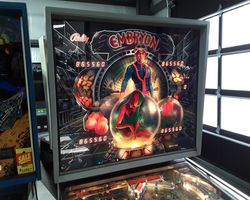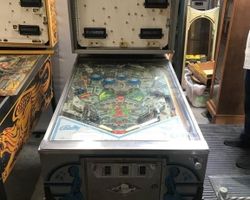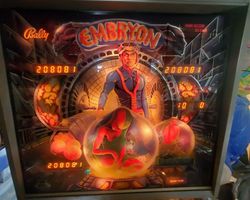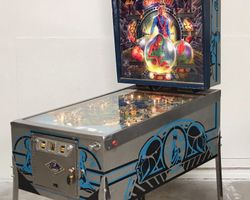Embryon
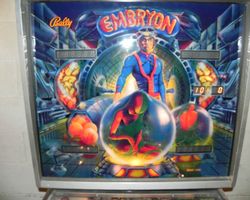
Average Prices: USD $400 to $2,500
Produced: June, 1981
Production Run: 2,250 units
Machine Type: Solid State Electronic
MPU: Bally MPU AS-2518-35
Players: 4
Design by: George Christian
Art by: Tony Ramunni
In June of 1981, Bally Manufacturing Company released Embryon, a solid-state electronic pinball machine that etched its distinctive presence into the history of the hobby. This widebody game arrived at a pivotal time for Bally, representing their final widebody pinball production before a significant corporate acquisition later that year. Embryon introduced players to a unique science fiction theme, inviting them on a "Journey to an Unexplored Reality," as one of its marketing slogans proclaimed. The concept art, notably by Tony Ramunni, indicated a visual direction aligning with the title, potentially drawing inspiration from a 1976 film also titled Embryo, known for its unsettling sci-fi narrative.
The creation of Embryon was a collaborative effort involving several talented individuals. Claude Fernandez took on the primary design responsibilities, shaping the playfield layout and gameplay flow. The striking visual identity of Embryon came from the artistic hand of Tony Ramunni. This machine marked Ramunni’s debut as an artist for Bally, making it a notable entry in his career. Prior to Embryon, Ramunni had contributed artwork to other manufacturers, often signing his work simply as "Ramunni." Embryon's backglass, however, showcased his full signature, a subtle shift in his artistic presentation. Rehman Merchant was responsible for the software development, bringing the game's mechanics and scoring system to life. With a production run of 2,250 units, Embryon emerged as a relatively scarce widebody machine from its era, contributing to its collectibility.
Signature Features and Design
Embryon distinguishes itself with several unique design elements and mechanical features, central to its gameplay and aesthetic appeal. Foremost among these is the "Flipsave" flipper, a Bally-trademarked innovation that saw its sole appearance on this machine. Positioned vertically in the right outlane, this shorter, timed flipper offers players a chance to save a draining ball, flipping it back into the return lane. This feature adds a layer of strategic depth and last-second excitement, providing a distinct mechanical assist rarely seen in other pinball designs.
Another defining aspect of Embryon is its intricate system of captive balls. The machine incorporates five captive balls in total, a notable number that significantly influences playfield interaction. Four of these are "messenger balls," with two positioned individually behind a drop target. The most complex and visually arresting setup involves a fifth captive ball, acting as a Newton ball, which propels two of the messenger balls within their chambers, creating dynamic action in the playfield's central area. This multi-ball captive system encourages precise aiming and provides satisfying kinetic feedback, enhancing the overall experience.
The widebody cabinet itself is a signature feature. Unlike standard pinball machines, Embryon's wider dimensions allowed for a more expansive and less constrained playfield layout, enabling the inclusion of these complex captive ball mechanisms and offering a distinct feel to gameplay. This extra space contributes to a more open playfield, where balls can gain considerable speed and momentum.
Visually, Embryon's artwork by Tony Ramunni is a focal point. The sci-fi theme is rendered with detailed, ethereal imagery, particularly on the backglass. The color palette and artistic style align with late 1970s and early 1980s science fiction aesthetics, depicting an otherworldly environment that complements the "unexplored reality" marketing. The custom speech, an emerging technology at the time, further immerses players in this thematic landscape, providing audio cues and effects that enhance the game's atmosphere.
Playfield and Mechanics
The playfield of Embryon is a thoughtfully designed expanse, leveraging its widebody format to create a rich and varied layout. At its core, the playfield features four pop bumpers, strategically placed to create lively, unpredictable ball movement. Two slingshots flank the lower playfield, providing additional reactive elements.
One of the primary objectives involves the array of drop targets: two banks of three drop targets and a solitary drop target. These targets often guard access to specific scoring opportunities or activate features, requiring players to aim with precision. Beneath the central complex of captive balls lies a kick-out hole, which can return the ball to the flippers or initiate special sequences. A rollunder spinner adds another layer of scoring potential, rewarding rapid shots through its lane.
A notable aspect of Embryon's playfield design is the inclusion of an upper playfield, accessed via a shot from the main playing area. This elevated section features a fourth flipper, offering distinct shots and challenging angles that differ from the lower flippers. The flow of the game often encourages players to hit shots that lead to this upper area, creating a multi-level experience. The design philosophy behind this layout emphasizes exploration and varied shot-making, preventing the game from feeling repetitive. Successful play often involves navigating the ball between the main playfield, the upper section, and the captive ball areas, maintaining momentum.
The artwork on the playfield integrates seamlessly with the mechanical elements, with detailed illustrations surrounding targets, lanes, and inserts. The lighting package enhances the thematic aesthetic, illuminating key areas and providing visual feedback for successful shots. While the lighting generally contributes to the atmosphere, some areas, such as the pop bumpers, can appear less lit, which can occasionally obscure parts of the underlying artwork.
Gameplay Dynamics
Embryon presents players with a multi-layered gameplay experience, driven by its unique playfield features and a progression system that encourages strategic engagement. The core objective often revolves around targeting the multiple drop targets to open up pathways to higher scoring elements or to interact with the captive ball mechanisms. Successfully hitting the two banks of three drop targets and the solitary target are key to advancing through the game’s stages.
The two-ball multiball is a central gameplay highlight. Initiating multiball typically requires fulfilling specific objectives, often involving precise shots to the captive ball areas or completing target banks. While achieving multiball is a challenging and rewarding endeavor, some players note that the scoring incentives during multiball, though present, are not as pronounced as in some other machines. This dynamic can lead to a focus on sustained play and strategic ball control rather than exclusively high-scoring multiball frenzy.
Player strategies on Embryon often involve mastering the various shots required to activate the captive ball sequences. The unique interaction of the Newton ball propelling other messenger balls creates opportunities for chain reactions and satisfying visual feedback. Strategic use of the "Flipsave" flipper in the right outlane becomes a critical skill, allowing players to extend ball times and recover from seemingly lost balls. This subtle yet impactful feature rewards quick reflexes and provides a distinctive ball-saving mechanic.
The game's progression system encourages players to explore the entire playfield. Shots to the upper playfield are crucial for activating certain features or collecting points, adding verticality to the gameplay. While some describe the game as having good flow, a few players might find the pace to be less frenetic than later designs, particularly if the machine is not optimally tuned. The audio package, featuring custom speech, complements the gameplay, providing thematic reinforcement and signaling important events or scores throughout the game.
Reception and Legacy
Embryon has cultivated a notable reputation within the pinball community, often regarded as a highly enjoyable and distinct machine, especially among Bally's widebody offerings. Its strengths are frequently cited, beginning with its engaging playfield layout. Players appreciate the sheer volume of interactive elements and shots available, which contribute to a dynamic experience that maintains interest across multiple plays. The effective utilization of the widebody cabinet is consistently praised; it provides ample space for the unique features and allows for a surprisingly fast and fluid game when properly adjusted.
The captive ball features, particularly the intricate central mechanism involving the Newton ball, are often highlighted as a standout and unique aspect that sets Embryon apart. The one-of-a-kind "Flipsave" flipper on the right outlane is another widely recognized positive, offering a distinct and helpful ball-saving mechanic that adds a layer of player interaction. The upper playfield, with its dedicated flipper, also receives positive feedback for adding strategic depth and varied shot opportunities.
Aesthetically, Embryon's artwork by Tony Ramunni garners considerable acclaim. It is frequently described as beautiful, detailed, and possessing a unique sci-fi aesthetic that strongly evokes the period. The backglass, in particular, is noted for its striking visuals. The sound and lighting package generally aligns with the theme, contributing to the overall atmosphere and player immersion.
However, Embryon is not without its specific critiques. The theme itself, while unique, is sometimes described as "peculiar" or "bizarre" by a segment of players. While the captivating gameplay often outweighs these thematic reservations for many, it remains a point of discussion. Another common point of feedback concerns the two-ball multiball. While challenging to achieve, some players feel it lacks significant scoring incentives or benefits, potentially reducing the excitement associated with activating it. Minor critiques include observations that certain parts of the playfield, like the pop bumpers, can appear under-lit, and that the outlanes can be punishing, leading to "no fault" drains in some instances.
Despite these minor points, Embryon's legacy is that of a collectible and cherished machine. Its relatively low production numbers for a widebody contribute to its rarity. It holds a nostalgic connection for many players who encountered it in their earlier years. As Bally's final widebody pinball machine before a significant company transition, Embryon stands as a unique timestamp in pinball history, encapsulating a particular design philosophy and showcasing innovative features that remain compelling decades after its release.
Sponsored Links
 Ebay Listings
Ebay Listings
 Auction Results
Auction Results
| Cost | Location | Date |
|---|---|---|
| USD $3,495 |  Ohio, United States Ohio, United States |
21 July, 2025 |
| USD $825 |  Tennessee, United States Tennessee, United States |
18 May, 2025 |
| USD $4,000 |  California, United States California, United States |
11 December, 2023 |
| USD $4,495 |  Illinois, United States Illinois, United States |
24 June, 2023 |
| USD $2,600 |  Oregon, United States Oregon, United States |
24 March, 2023 |
| USD $2,000 |  Georgia, United States Georgia, United States |
11 March, 2023 |
| USD $2,400 |  California, United States California, United States |
23 January, 2023 |
| USD $6,995 |  Canada Canada |
06 September, 2022 |
| USD $4,050 |  Minnesota, United States Minnesota, United States |
10 April, 2022 |
| USD $2,200 |  California, United States California, United States |
30 August, 2021 |


Private Policy · Search Website · Contact Us
As an eBay Partner, we may earn a commission from qualifying purchases made through links on this site, at no additional cost to you.
All trademarks and copyrighted materials remain property of their respective owners. All other content copyright 2007 - 2025 Pinpedia.

